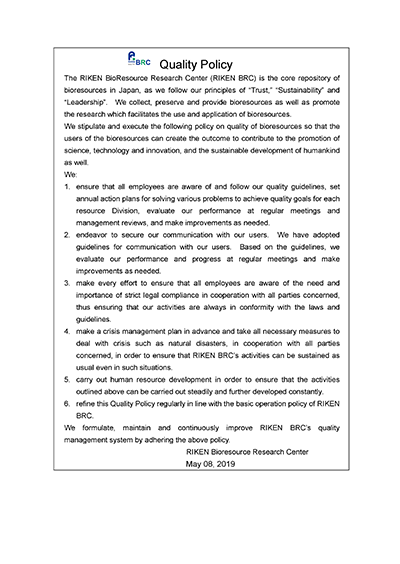From quality management based on ISO 9001 international standards to RIKEN BRC’s own quality management
In the field of life sciences, the quality of bioresources used in research significantly impacts research outcomes. To continuously improve the quality of bioresource services provided to users, the RIKEN BioResource Research Center obtained certification under the international quality management standard ISO 9001 and has been striving to enhance the quality of bioresources through the implementation of the PDCA cycle since 2007.
Through 19 years of implementing ISO 9001, the quality of resources provided by RIKEN BRC has greatly improved. To build on this achievement and further improve quality, we are developing our own quality management system specialized for operations of bioresource project, based on the expertise gained through our implementation of ISO 9001. To this end, we have launched the following initiatives starting in FY 2025.
1. Formulation of Quality Management Policy
Our Quality Management Policy (strategy related to quality, formerly known as “quality policy”) was released in April 2025, clearly stating the establishment and implementation of a specialized quality management system.
2. Establishment of a PDCA cycle driven by RIKEN BRC
With the aim of further improving quality, we will shift the resources spent on maintaining and renewing certifications from a top-down approach to a bottom-up (participation by all) approach to quality management activities.
3. Deployment of the quality management system across all RIKEN BRC resources
RIKEN BRC will implement its own quality management system even in divisions which do not have experience in operating quality management based on the ISO 9001 certification, such as the Experimental Animal Division, Experimental Plant Division, and Gene Engineering Division.
Role of the Support Unit for Quality Management
Through establishing RIKEN BRC’s own quality management system and supporting its smooth operation, we will further improve the quality of the bioresources provided by RIKEN BRC. In turn, this will contribute to the advancement of life science research and the sustainable development of human society.
